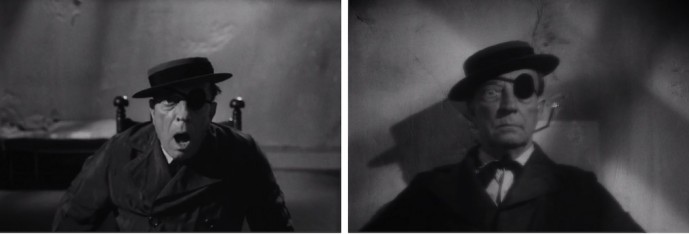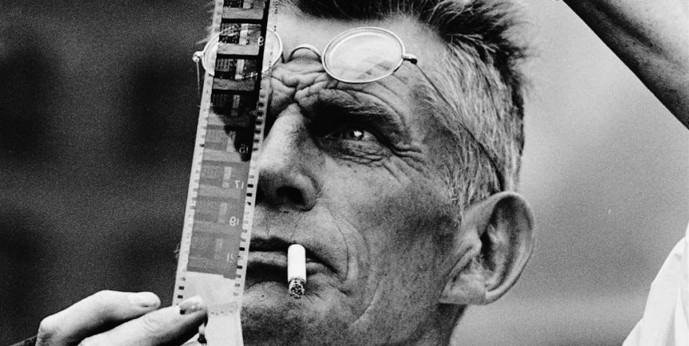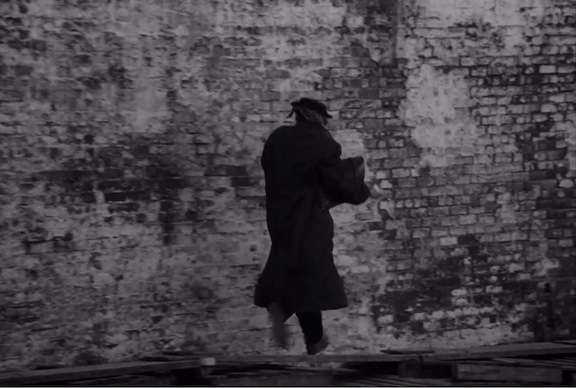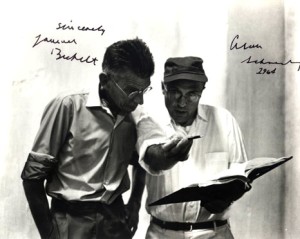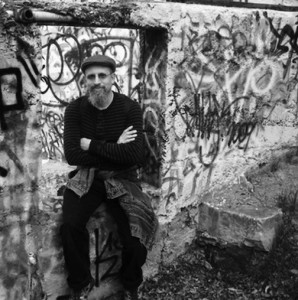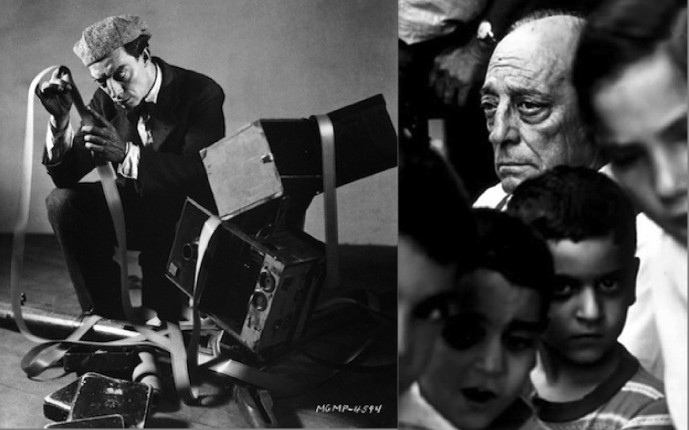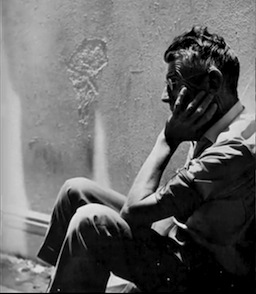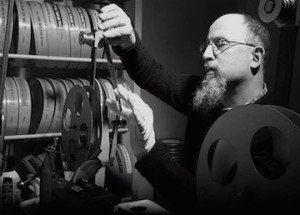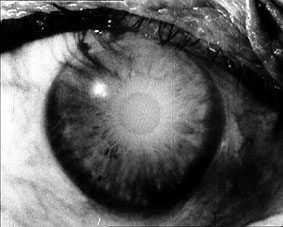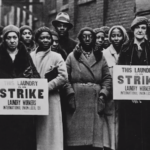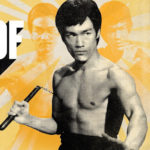An Odd Couple: Samuel Beckett & Buster Keaton
After seven years of work, and many years of research and analysis, a noted film archivist has completed his meditation on one of the most surprising of cinema collaborations.
by peter monaghan
n
n
Some 50 years ago, the playwright and novelist Samuel Beckett and the silent-era film star Buster Keaton worked together on a singular creation of cinematic art.
Beckett’s only film, film, has for several years engaged a renowned restorationist, Ross Lipman. After first restoring film, he has been making a film about it.
Until July 2015 a long-time senior film restorationist at the University of California at Los Angeles Film & Television Archive, but now working independently, Lipman has won high honors in film restoration for his remarkable work on a string of important films. He has also long pursued an idiosyncratic course in film commentary and film making. He created collage works in the 1980s, “narrative portraiture” in the ’90s, and more recently video and pictorial essays, and in all of those he has rethought the conventional parameters of film art and craft.
Now, as 2015 draws towards its close, Lipman has completed notfilm, his feature-length “documentary essay” or “kino-essay.” It tells of how Beckett’s 22-minute film dealt in striking ways with many aspects of motion-picture history, and more generally, the nature of spectacle, of perception, and of being perceived by self and others – what Beckett later called “the agony of perceivedness.” film was, as Lipman puts it, Beckett’s “friendly and humorous” response to how recorded images bear on the pronouncement of the 18th-century Irish philosopher George Berkeley’s pronouncement, esse et percipi: “To be is to be perceived.”
n
That, rather than the aged Keaton’s key presence, is at the core of film. As it opens, an eye fills the screen, and then the camera pursues through an urban landscape a scruffy man in an overcoat whose face is obscured, but who wears the flat-topped hat associated with Buster Keaton, so that the silent-film star is obliquely present. At the end of the film, the camera does catch up with the napping Keaton character, and viewers catch sight of his distinctive face, although with one patched eye.
It’s no ordinary chase, but rather one “between camera and pursued image that finds existential dread embedded in the very apparatus of the movies itself,” stated the notes to a 4K restoration that Lipman and his UCLA colleagues made in 2011 for Anthology Film Archives, in cooperation with the British Film Institute, and that Milestone Film & Video issued (so far, only for institutional sales; but see below).
The collaboration that Lipman characterizes as “one of the strangest experiments in movie history” – and that only devotees of avant-garde theater and film history are likely to know exists — took place well into Beckett’s career in fiction and theater, which five years later would attract a Nobel Prize in Literature.
In 1962, Barney Rosset, the founder in 1951 of the radical Grove Press, formed the Evergreen Theater to commission film scripts from Grove authors, and a couple of others. Publishing had diverted Rosset’s own strat in filmmaking: in 1948, he had made Strange Victory, a “semi-documentary” film about the racism faced by black soldiers returning from World War II. Now he sounded out Harold Pinter, Eugene Ionesco, Marguerite Duras, Alain Robbe-Grillet, and Beckett, who all agreed to the idea, and Jean Genet, who declined as did two non-Grove authors, Gunter Grass and the Austrian writer Ingeborg Bachman.
Pinter’s 1964 script, The Compartment, was not made, but he reworked it later for television as The Basement. Ionesco’s contribution was The Hard-Boiled Egg; “due to some very complex and very expensive special effects,” Rosset did not succeed in having a film of that made until 2005, when James Foutopoulos shot one. Duras and Robbe-Grillet both wrote full-length scripts but, Rosset wrote in 2000, “for both scripts the timing was wrong” and Rosset never made them.
Rosset entrusted Beckett’s script, the only one to be filmed right away, to Alan Schneider, who was one of his partners in Evergreen Theater, and who had directed American productions of plays of Pinter and Edward Albee as well as of Beckett, with whom he had become a good friend.
Schneider immediately faced challenges. His nearest experience to film making had been to direct a television production of Waiting for Godot. He found Beckett’s six-page script “fairly baffling when not downright inscrutable.” It came “with pages of addenda in Sam’s inimitable informal style: explanatory notes, a philosophical supplement, modest production suggestions, a series of hand-drawn diagrams.” Those included, “in cosmic detail, his principal characters, O and E, the question of ‘perceivedness,’ the angle of immunity, and the essential principle that esse est percipi: to be is to be perceived. All composed with loving care, humor, sadness, and Sam’s ever-present compassionate understanding of man’s essential frailty. I loved it even when I wasn’t completely sure what Sam meant.”
Buster Keaton ended up in the film because Beckett’s first choice, Charlie Chaplin, was by then not even reading scripts, and Beckett actor Jackie MacGowran was otherwise engaged, as was another actor Beckett considered, Zero Mostel.
Schneider said the thinking was that any of those would be “in keeping with Sam’s feeling that the film should possess a slightly stylized comic reality akin to that of a silent movie.”
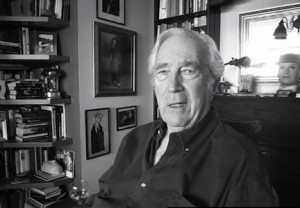 The idea of using Buster Keaton came from a supporting-role actor, James Karen, who knew Keaton well. Although Keaton had declined in 1956 to play Lucky in the Schneider-directed American premiere of Waiting for Godot, Schneider traveled to Keaton’s Hollywood home to “woo” him, and succeeded.
The idea of using Buster Keaton came from a supporting-role actor, James Karen, who knew Keaton well. Although Keaton had declined in 1956 to play Lucky in the Schneider-directed American premiere of Waiting for Godot, Schneider traveled to Keaton’s Hollywood home to “woo” him, and succeeded.
In July 1964, Beckett and Schneider convened a two-day pre-production meeting of the crew at Rosset’s summer house in the Hamptons, on Long Island. Schneider had had to bend Beckett’s arm to come: “New York, he assumed, would be too loud and too demanding, too many interviews and cocktail parties. He preferred the quiet of Paris and his country retreat at Ussy. But to work on this one, he would.” Once Beckett was there, Schneider would cede much directing control to him.
The cameraman would be Boris Kaufman, who had won an Academy Award for his cinematography on Elia Kazan’s 1955 film starring Marlon Brando, On the Waterfront, although Rosset was at the time unaware of that work. Kaufman was the brother of an avant-garde filmmaker of some renown, Dziga Vertov; but above all Rosset hired him because he had shot two of Rosset’s favorite films, both by Jean Vigo: Atalante in 1934 and Zero de conduite in 1933.
The editor would be Sidney Meyers, an acclaimed filmmaker and, according to Rosset, “a consummate musician, a self-effacing, literate, and intelligent man” who “got along beautifully” with Beckett.
Little more than a week after that meeting, the film was shot over 11 days, with the camera chase, then a 5-minute scene on some stairs, followed by a 17-minute sequence in a room.
Just a week later, after some initial editing alongside Meyers, Beckett returned to France, and his only visit to the US was over.
The film would emerge a year later, with a September 1965 screening at the Venice International Film Festival, where it was acclaimed, then a second screening at the New York Film Festival, as part of a Keaton tribute, where it again won an honor even though it was booed and then panned by Bodley Crowther of the New York Times, who called it “a miserable and morbid exercise, done entirely in pantomine, in which Mr. Keaton, still wearing his familiar flat hat and rumpled clothes, plays a gloomy, grotesque, eye-patched fellow who is alienated from society and from all God’s creatures and even rejects himself.” The film was, Crowther wrote, “a cruel bit of obvious symbolism in which to involve an old star who has given a lot of pleasure to millions of people.” European screenings followed; Sunday Times reviewer Dilys Powell dismissed film as “a load of old bosh.”
Over time, analysts of what is actually in the film, as distinct from what its first reviewers thought should be in it, have suggested that Beckett actually knew what he was doing in making a virtually silent film that was not a “silent film” in the usual sense. The philosopher Gilles Deleuze would call the result the “greatest Irish film,” and he has been among many analysts and theorists of culture to find the work provocative. One peculiar response to it came in 1979 when the British Film Institute produced a re-make, Film: A Screenplay by Samuel Beckett, directed by David Rayner Clark and with Max Wall, a film and Beckett stage actor, in the role Keaton had played. Beckett took no part in the production; nor apparently had he said anything about it by the time he died in 1989.
When Ross Lipman began to make his film about Beckett’s film, he had all this to ponder. He had come upon t
When Ross Lipman began to make his film about Beckett’s film, he had all this to ponder. He had read Beckett’s script years earlier, while a student at the University of Michigan. He then studied there under Rudolf Arnheim, a noted German theorist of the perception of art who had influenced Beckett’s view of film. Lipman, on learning that Arnheim was unfamiliar with Beckett’s sole venture into film making, wrote a term paper about it.
Fast forward three decades, and Beckett’s film would reenter Lipman’s life. Andy Lampert of Anthology Film Archives, knowing he would be interested in restoring the film for a new edition that Milestone would issue in 2011, introduced him to Barney Rosset at Grove Press, and Lipman began a series of meetings with the publisher.
Lipman knew that Beckett had had to cut back the opening scenes of the film from eight minutes to one due to problems that arose during the first day of filming. Schneider had described those in such terms as beginning-director problems, light problems, traffic problems, actor problems, camera problems, wobbling dollies, and ill-matched swish pans. And then other hitches became apparent when Rosset, Schneider, and Beckett watched the day’s rushes.
The whole schema of the film shoot posed challenges that, in Rosset’s 2000 account, the crew seemed to try to resolve by improvisation: Kaufman sought to render Beckett’s desire that his film present “two perceptions, the extraneous perception and [the Keaton character’s] own acute perception, that is, the eye that follows that sees him and his own hazy, reluctant perception of various objects” by using tones of light to differentiate the two, but fell short.
Beckett’s ambitions for the opening, a prologue, similarly stumped the crew, and no wonder. Rosset recounted that it was meant to consist of “one very long shot in which a number of actors would make their only appearance. The shot was based on Orson Welles’s Citizen Kane, wherein Welles and his genius cameraman, Gregg Toland, achieved ‘deep focus.’ Even when panning their camera, “deep focus” allowed objects from as close as a few feet to as far away as several hundred to be seen with equal clarity. Toland’s work was so important to Welles that he gave his cameraman equal billing to himself. Sad to say, our ‘deep focus’ work in Film was unsuccessful.”
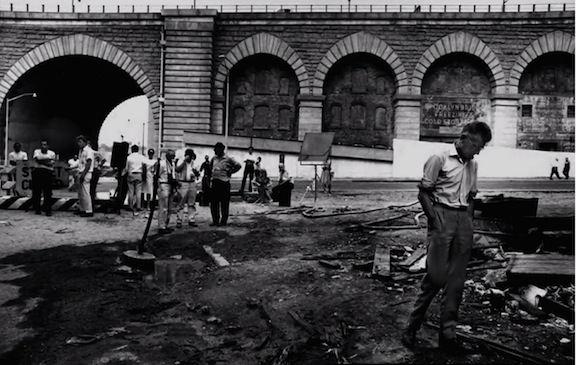
The shooting of the film’s prologue, outdoors in Manhattan, near the Brooklyn Bridge, was beset by problems. Beckett pondered what to do, and settled on a major revision of his film’s opening sequence.
The problems forced Beckett to cut the prologue from eight minutes to one: “Despite the abundant expertise of our group, the extremely difficult shot was ruined by a stroboscopic effect that caused the images to jump around. Today it would probably be much easier to achieve the effects we wanted to capture. Technology is now on our side. Then, the problems proved too much for our group of very talented people so we went on without that shot.” Going back to reshoot was not possible, says Lipman: Beckett had wanted many extras for the prologue’s exterior shoot, and got them for the first day of shooting, but after all the problems, cutting was preferred to “trying to call all the extras back, which they didn’t have money for anyway.”
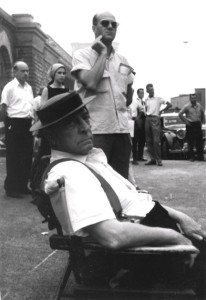 Beckett quickly reconceived the prologue as a one-minute sequence with only two extras. Lipman says: “When I would visit Barney in New York, he would often lament the loss of that scene. He talked about it all the time because as a producer that was their most complicated piece of business, and so much work had gone into it. For him, and for everybody, it would have been a very different film if it had opened that way.”
Beckett quickly reconceived the prologue as a one-minute sequence with only two extras. Lipman says: “When I would visit Barney in New York, he would often lament the loss of that scene. He talked about it all the time because as a producer that was their most complicated piece of business, and so much work had gone into it. For him, and for everybody, it would have been a very different film if it had opened that way.”
Lipman naturally wanted Rosset to tell him all about what had transpired. “On one of my visits to Barney, he did mention that he still had some leftover material, but he thought it was mainly scrap, and that none of it was any good.”
Where was that footage?
“Under his kitchen sink.
“And being an archivist, I of course wanted to look at it anyway and Barney generously let me do so. And the remains of the prologue were there.”
For his notfilm, Lipman has reconstructed how the prologue might have run: “I was able to use those outtakes along with production stills and details from the script and notes to reconstruct a version of the scene that is 6 minutes long,” he says. “After we digitized these outtakes, the strobing isn’t too bad, but there was not enough footage to do the whole 8 minutes. They did not shoot everything, or if they did, some of that remaining footage is lost.”
Lipman uses just one minute of the reconstruction in notfilm, proper, and stresses that it is a reconstruction of what Beckett might have made, rather than a restoration of what he did make; but the whole 6-minute piece will come with the DVD/Blu-ray package that will accompany the issue of notfilm. In a demonstration of how highly they consider Lipman’s distinctive work, Amy Heller and Dennis Doros, the founders of the film-reissue company Milestone Film & Video, are making notfilm their first foray into film production, and will issue it in a bundle with the 4K restoration of film, along with other extras.
In mulling what to make of Beckett’s film, Lipman has further benefitted from an audio recording of some of the pre-shoot production meeting that Rosset gave him. That reel was not under that sink, he says; in fact, “it was known to Beckett scholars previously, and some excerpts were published with Beckett’s permission; but the recordings have not been heard, and one does gain quite a bit by hearing the spoken sound of their voices.” The recordings provide insights into the working method of Beckett, who was notoriously shy of being filmed or recorded, says Lipman. “They discuss the problem of bringing Beckett’s abstract conception into the world of practice, in the reality of the film shoot. That was the challenge they faced.”
It was a Beckettian vision, and “he was the first to admit that he didn’t have the technical skills to realize it.”
Nor could the affable Beckett crack the reserve of Keaton, who came to the New York filming fresh from Canada, where he was hired to appear in The Railrodder. He arrived in New York too late to make the production meetings of film, and more’s the pity, because he might have benefitted from attendance. Once filming began, he commented more than once that he had no idea what was going on. Even after filming, in September 1965, when he appeared at the Venice Film Festival and was asked what he thought of Beckett’s film, he said: “I don’t know what it was all about; perhaps you can tell me. The camera was behind me all the time. I ain’t used to that.”
He had been even more emphatic in an interview with film critic and historian Kevin Brownlow, before editing had been completed: “I didn’t pay much attention to it,” he had said. “It was a wild daydream he had. I don’t think it meant a damn thing.”
In October 1965, he told Rex Reed of the New York Times: “The director, Alan Schneider, just told me to keep my back to the camera and be natural.
“Just try acting natural with the camera crew aiming at your back.” He added, obscurely: “As for Samuel Beckett, I took one look at his script and asked him if he ate Welsh rarebit before he went to bed at night.”
Beckett told Kevin Brownlow that he found Keaton “very competent” and “his movement was excellent,” and that he seemed to enjoy helping to create one of the film’s several scenes; yet, he also found the actor “inaccessible” behind “a poker mind as well as a poker face,” and appeared not ever to have read the film’s script. “I don’t think he approved of it or like it,” Beckett told Brownlow.
The misfiring between Beckett and Keaton had begun when the two first met. Schneider, who introduced them one afternoon at Keaton’s hotel, wrote that Beckett was eager for the meeting as “he had known and respected his work since the days of the old silent films,” while Keaton, “knowing of Sam’s standing as a playwright and novelist, was intrigued, but didn’t really know what to make of a man like Beckett.” According to Barney Rosset, when Beckett arrived at Keaton’s rooms, “he had to wait in a separate room while Keaton finished up an imaginary poker game with, among others, the legendary (but long-dead) Hollywood mogul Irving Thalberg.” When Beckett was able to enter, he found the actor drinking a beer and watching baseball on television, and kept watching it after an awkward exchange of greetings. “I don’t even think he offered us a beer,” says Schneider. “Not out of ill will; he just didn’t think of it. Or else maybe he thought that a man like Beckett didn’t drink beer.” But even when he and Beckett persisted, “it was no use. Keaton would answer in monosyllables” and return to the game. “It was harrowing. And hopeless.”
All the more so because if Keaton had looked into the matter more closely, he might have discovered that Beckett was quite a sportsman, himself – he had played first-class cricket for Trinity College Dublin. At high school he had also stood out in rugby, golf, tennis, swimming, boxing, and diving. It surely should bear more on Beckett scholarship that during his one and only visit to the United States, he spent a day at New York’s Shea Stadium watching the Mets, happily.
With all the disconnect with Keaton, Beckett didn’t press him to consider the meaning of his film, which he described in his script as “comic and unreal.” When Brownlow asked Beckett whether he had ever explained the film to Keaton, the playwright said “I never did, no.”
It was clearly no easy task to divine the meaning. Even Schneider struggled. Pre-production, he posed to Beckett “a thousand questions, largely by mail and eventually in person at his Montparnasse apartment; trying to visualize graphically and specifically the varied demands of those six tantalizing pages.” But then, “gradually, the mysteries and enigmas, common denominators of all new Beckett works, came into focus with fascinatingly simple clarity.”
Well, asked Brownlow, what was it about? Beckett told him: “It’s about a man trying to escape from perception of all kinds – from all perceivers, even divine perceiver. … But he can’t escape from self perception.” That Beckett said, was the perception Bishop Berkeley had had.
Keaton’s reticence seems odd, both because his fame derived in part from physical humor even if his expressively deadpan face was his trademark, and because the general conceit of Beckett’s film is hardly that obscure. Keaton may have understood more than he let on – at least, he supposedly told a reporter that the film’s meaning was “a man may keep away from everybody but he can’t get away from himself.”
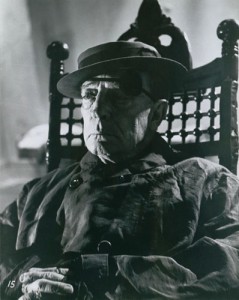 Schneider supposedly considered Keaton not smart enough to get what Beckett was up to, which certainly included making use of his own perception that sorrow and remove alloyed Keaton’s presence and humor. Beckett seems genuinely to have liked Keaton, regardless of their missed connection. Tom Dardis wrote in Keaton: The Man Who Wouldn’t Lie Down that during the filming, the crew adjourned at lunchtimes to an Upper West Side restaurant where Keaton spoke in detail of his 1920s experiences making films with his own production company, and “Beckett would listen intently to Buster’s stories, a small smile of pure delight on his face.”
Schneider supposedly considered Keaton not smart enough to get what Beckett was up to, which certainly included making use of his own perception that sorrow and remove alloyed Keaton’s presence and humor. Beckett seems genuinely to have liked Keaton, regardless of their missed connection. Tom Dardis wrote in Keaton: The Man Who Wouldn’t Lie Down that during the filming, the crew adjourned at lunchtimes to an Upper West Side restaurant where Keaton spoke in detail of his 1920s experiences making films with his own production company, and “Beckett would listen intently to Buster’s stories, a small smile of pure delight on his face.”
That affinities connected the two men is assumed by many literary and film critics. “Surveying five decades of critical writings on Keaton, I lost count of the comparisons to Beckett,” Imogen Sara Smith wrote in her study, Buster Keaton: The Persistence of Comedy. “Only Chaplin’s name turn up more often.”
Beckett “never considered film as having fully attained his vision for it” but did recognize that it had “considerable power,” says Lipman. “He alludes to a palpable presence of some kind, a feeling that emerges in watching it, that is beyond concept, that is more of an emotional state. I interpret that as being a result of both his work and also Boris Kaufman’s, because Kaufman’s cinematography is extraordinary. There’s an ethereal quality of light.”
But due to his reservations, when in later years Beckett “very much continued with the moving image, he made a very conscious decision not to return to photochemical works but to make works for television. In the confined space of the television studio he was able to have tighter control over certain details than he was able to get on a film set.”
Notfilm will have its festival release 17 and 18 October 2015 during the BFI London Film Festival. The Milestone Film worldwide DVD and Blu-ray commercial release of both Beckett’s
film in the 4k restoration that Lipman made in 2011 at the UCLA Film & Television Archive and Lipman’s Notfilm is expected to take place in early 2016; BFI will handle UK release.
Notfilm has interviews with Barney Rosset, just before he died; James Karen, who as Keaton’s friend was on the set during much of the production; cinematographer Haskell Wexler; the now-late Beckett actor Billie Whitelaw; film critic Leonard Maltin, who visited the set as a 13 year old; Kevin Brownlow; and others.
Restorations: Charles Burnett’s Killer of Sheep, Kent Mackenzie’s The Exiles, the Academy Award-winning documentary The Times of Harvey Milk, and works by Charlie Chaplin, Orson Welles, Shirley Clarke, Kenneth Anger, Barbara Loden, Robert Altman, and John Cassavetes. Recent projects: Thom Andersen’s Eadweard Muybridge, Zoopraxographer and (with Conner Family Trust) Crossroads.
Awards: Anthology Film Archives’ Preservation Honors, 2008; three-time winner of the National Society of Film Critics’ Heritage Award.
Publications: essays on film history, technology, and aesthetics in Artforum, Sight and Sound, and many academic books and journals.
Filmmaking: Films screened and collected by the Oberhausen Kurzfilm Archive, Budapest’s Balazs Bela Studios, Munich’s Sammlung Goetz, The Academy Film Archive, Anthology Film Archives, and Northeast Historic Film.
Previous Post: Black-and-White is Dead. Long Live Black-and-White
Next Post: UCLA Inaugurates New Education Approach

